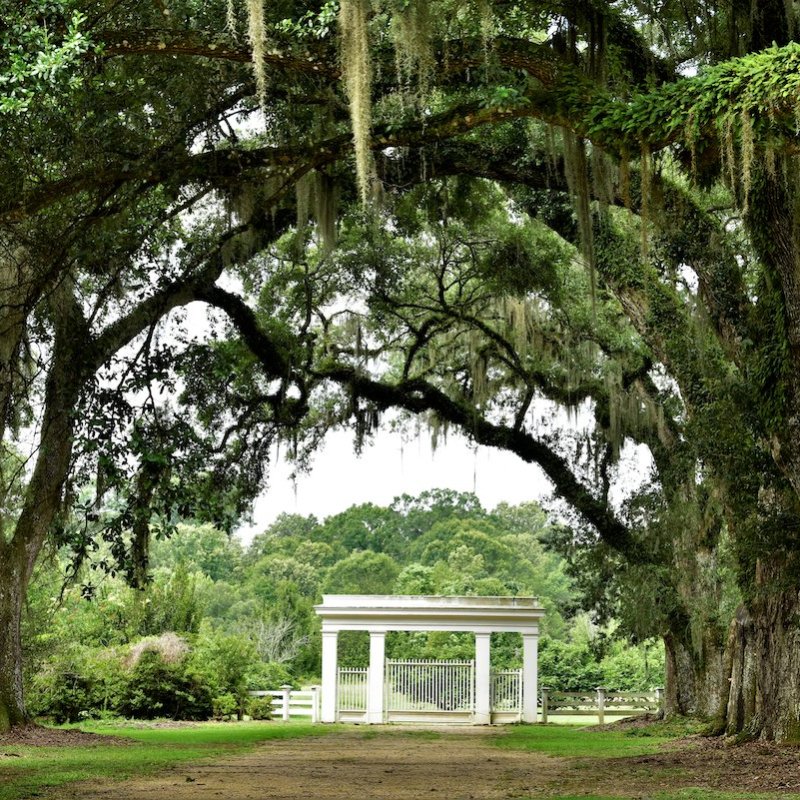
New Orleans is a great city with tons to do and a vibrant cultural history, but like many cities, it can be crowded with lots of traffic. These cute small towns are an easy drive from New Orleans for a day trip. Another option is to make it a longer trip and explore Louisiana’s fabled Great Mississippi River Road, which stretches for 70 miles on both sides of the river between Baton Rouge and New Orleans. This area of the country is a mix of African, French, Spanish, Native American, German, and English influences. The result is Cajun and creole cuisine, historic homes, the Andouille Trail (a local sausage), and zydeco music. It is a rich cultural experience you will never forget.
Videos by TravelAwaits
Portions of this article are inspired by a press trip I arranged with Louisiana River Parishes. My family is also from the area and I grew up exploring the Great River Road.

Peggy Cleveland
1. Destrehan
Destrehan is right outside of New Orleans and is named for Jean-Noel Destrehan. His home, Destrehan, is one you must visit while in the area. It is famed for the many movies filmed here including Interview with a Vampire. There are a variety of tours, but I highly recommend The Unheard Voices of the German Coast Tour. It is offered exclusively by Dianne Honor, a family descendent who shares the stories of the German farmers, Acadians, enslaved Africans, and Native Americans who settled this area. Honore is a gifted storyteller, and her family history lends an authenticity to this tour, which is a moving, unforgettable experience.
If you would like to stay in the area, Destrehan has two creole cottages you can rent to overnight on the property. It is very quiet at night and a little eerie. You can almost hear those unheard voices. One popular local place to eat is the Seafood Pot. Great local seafood and you can get drive-thru frozen daiquiris, an authentic Louisiana experience. In the morning, head over to the Honeydoux Cafe and Bakery for some breakfast. Owner Katie Hymel is a master baker, and she has a loyal, local following. Try the Ryan, a biscuit with sausage and grape jelly, simple but yummy.

Peggy Cleveland
2. LaPlace
La Place is located on the east side of the river. The 1811 Kid Ory Historic Home is a newly opened museum that tells two stories, one of tragedy and one of hope. A 1811 rebellion of enslaved people began at this home, which is one of the oldest in St. John the Baptist parish. If you are lucky, John McCusker, the Managing Director, will give your tour. He is so knowledgeable about the history of the area and is a lover of jazz. The story of hope is that of Kid Ory, a pioneer in the history of jazz. Many jazz greats got their start in his band.
Not too far away is Petra Restaurant, a perfect place for lunch. The menu is Mediterranean with a Louisiana influence. Make sure to try the eggplant cake with crabmeat sauce. The stuffed shrimp in phyllo dough pairs shrimp stuffed with seafood and wrapped in phyllo dough. Very unique and oh so good. If you prefer chain hotels, you will find a wide selection in LaPlace.
St. Michael the Archangel Catholic Church in Convent is also worth a visit. The church exhibits Roman and Gothic styles and was built in 1833 although the parish dates to 1809. It is well known for its Lourdes Grotto, which was constructed in 1876. Outside, take some time to wander through the raised graves of the cemetery. Mimi Zilla, a woman of color, donated the land to build the church on.
3. Reserve
Located on the east side of the Mississippi in Reserve, you must take a tour with Historic Riverlands. Located in the historic Our Lady of Grace Sanctuary, they offer a variety of tours that let you see the sights, taste the food, and hear the music of the African American people who lived in this area. The Soul River Musical Journey highlights the music during segregation, integration, the Civil Rights Movement, and the Black Lives Matter Movement.
The Godchaux House in Reserve was built in 1764 and is one of the older homes on the Mississippi River. It is worth a drive by to see the architecture of a historic creole cottage. Another home worth visiting is the San Francisco, which is a few miles from Reserve. It features a style of architecture known as Steamboat Gothic due to its resemblance to the steamboats that passed the home along the Mississippi. It is truly unique.

Peggy Cleveland
4. Vacherie
Plan to hang your hat for a while because there is so much to do in this area. For lodging, plan to stay at the iconic Oak Alley Plantation. The Inn and Restaurant are independently owned but you do have access to the plantation grounds during your stay. These cottages are super luxurious and equipped with mini kitchens, which is a plus as many of the local restaurants are 20 to 40 minutes away.
Pro Tip: The restaurant does not serve dinner, but you can preorder a meal by 2 p.m. the day before your arrival. It will be waiting in your cottage to heat up for dinner.
Cajun cooking and the Andouille Trail are big in Vacherie. Book a Cajun Cooking Experience with Spuddy, who was nicknamed after Sputnik the Russian satellite, not the potato, and learn how to make some Cajun specialties including Andouille sausage. He is so much fun and he has a huge following on Facebook with his live cooking show.
Another fabulous place to visit is the B and C Seafood Market and Cajun Restaurant, which has been featured on Feasting on Asphalt/Waves hosted by Alton Brown. The owner let me sample four types of gumbo when I visited. Locals come by for their daily plate lunch special. A plate lunch is a hearty meal special for the workers in the area.
In addition to touring Oak Alley Plantation with its Rediscover Oak Alley experience that incorporates the narrative of enslaved people into the tours, you will want to visit Laura Plantation, which was the first tour in Louisiana to use the term slave instead of servant in its tours — and that was in 1994. Here, you’ll experience a detailed tale of a family of both the plantation owners, the enslaved, and the descendants both black and white who were related to each other. The contrast of their lives is dramatic. Whitney Plantation is a history museum and memorial to the lives of the enslaved people. It is a very emotional experience to tour this site.
Pro Tip: Take some time to explore the grounds of Oak Alley and walk out to the levee for good views of the Mississippi and to take the iconic photograph of Oak Alley’s Oak Trees.

Peggy Cleveland
5. St. Francisville
This is one of the most charming towns in Louisiana. The downtown area is easily walkable with many museums, shops, and restaurants nestled among historic homes with grand oak trees draped with Spanish moss. Make sure to visit the West Feliciana Historical Society Museum to learn about the fascinating history of this area.
A must-see site in the area is the Rosedown Plantation State Historic Site. This state park preserves one of the most intact plantation groupings in Louisiana including the main house, historic gardens, 13 historic buildings, and 371 acres. It is a lovely park to visit, and you can tour the house and grounds or just the grounds. You will also want to visit the Audubon State Historic Site. John James Audubon painted 21 of his famous bird illustrations while living at the Oakley Plantation. The lush natural setting with a 100-acre forest filled with a variety of birds still inspires.
Pro Tip: One of the best meals I have ever had was at the St. Francisville Inn. People drive out from Baton Rouge because the food and service is so good. I dined on the Redfish Lafitte, a lightly blackened redfish topped with jumbo lump crabmeat and lemon beurre blanc, served over a braised spinach. I still dream about this meal. It was so good.
Author’s Note: There is a lot of controversy about staying or having events at a Southern plantation or spending any money at a plantation. The mindset is that it glorifies slavery and does not consider the lives of the enslaved. All the plantations mentioned in this article are nonprofits and have made a conscious effort to incorporate the stories of enslaved people into their narratives. In many cases, the Black architects and builders are highlighted, and these achievements should be recognized. The contrast of great wealth and unbearable hardships is part of the complex history of Louisiana. Tourism is vital to these communities along the River Road. Visits to these plantations bring those well-needed dollars into these local communities, providing jobs to the diverse local population.
For more Louisiana travel inspiration, consider:
